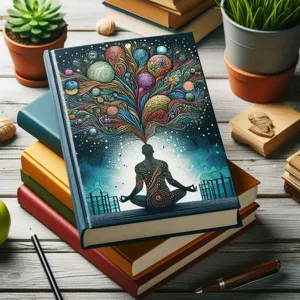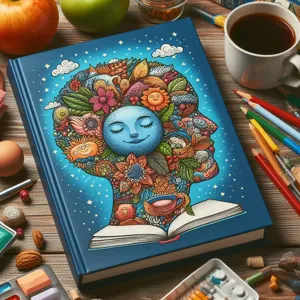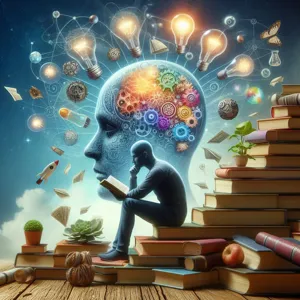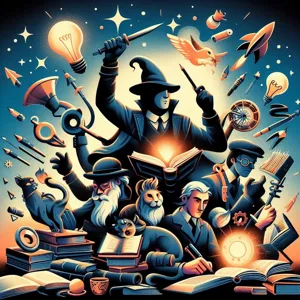In a world overflowing with information, the quest for wisdom often feels both exhilarating and overwhelming.
Books have long served as vessels of knowledge, offering insights that can illuminate our paths and transform our lives. But with so many options available, finding the right titles that not only share profound life lessons but also translate those insights into practical advice can be a daunting challenge. In this blog post, we will explore the art of unlocking wisdom through literature, guiding you on how to identify and select books that resonate with your personal journey. From timeless classics to contemporary gems, we’ll delve into the characteristics that make a book truly transformative, equipping you with the tools to enrich your life and foster personal growth through the pages of a book. Prepare to embark on a literary adventure that promises to inspire and empower you to embrace change and navigate life’s complexities with confidence!
1. Understanding the Importance of Transformative Literature

In a world overflowing with information, transformative literature stands out as a beacon of insight and wisdom. But what exactly do we mean by “transformative literature”? These are the books that not only entertain but also challenge our perspectives, provoke critical thinking, and inspire personal growth. They often encapsulate profound life lessons, drawing from the experiences and reflections of their authors, and providing readers with practical advice that can be applied in everyday life.
Understanding the importance of transformative literature begins with recognizing its power to shape our beliefs and behaviors. These books can serve as guides through life’s complexities, offering strategies to navigate challenges, make decisions, and foster resilience. whether it’s a memoir of overcoming adversity or a philosophical exploration of purpose, transformative literature provides readers with tools to reflect on their own lives and the world around them.
Additionally, the narratives within these books can forge connections between the reader and the author, creating a shared space of vulnerability and understanding. This bond often leads to a deeper appreciation of diverse experiences and perspectives, encouraging empathy and open-mindedness. By immersing ourselves in transformative literature, we invite the wisdom of others into our lives, enabling us to learn from their journeys and apply those lessons to our own.
Ultimately, the importance of transformative literature lies in its ability to inspire action. It challenges us to step outside our comfort zones, confront our fears, and pursue our true potential. In a society that often emphasizes surface-level interactions, these books encourage us to delve deeper, fostering a sense of purpose and direction. As we explore the world of transformative literature, we unlock doors to personal growth and enrich our understanding of what it means to live a fulfilling life.
2. Identifying Life Lessons Worth Exploring
Identifying life lessons worth exploring is the cornerstone of discovering transformative literature that resonates deeply with your personal journey. In a world overflowing with self-help books and motivational tomes, it can be daunting to sift through the noise and find the gems that genuinely offer actionable insights. Start by reflecting on the areas of your life where you seek growth or improvement. Are you looking to enhance your relationships, boost your career, or perhaps cultivate a more mindful approach to daily living? Pinpointing these key areas will guide your search and ensure that the lessons you delve into align with your aspirations.
Once you have identified your focal points, consider the themes that have historically captivated you. Do you find inspiration in stories of resilience, or are you drawn to practical strategies for financial success? Engaging with diverse perspectives can also be enlightening—explore books that share life lessons from different cultures, philosophies, or experiences. You might be surprised at the wealth of wisdom that exists beyond your immediate realm.
Additionally, leverage the power of community and recommendations. Discuss your interests with friends, family, or online groups, and solicit their suggestions on books that have profoundly impacted their lives. Often, personal anecdotes can lead you to unexpected treasures that may not be on the best-seller lists. Finally, don’t shy away from reading reviews or summaries to gauge whether a book’s lessons resonate with you before committing to it. By being intentional in your exploration, you can unlock a trove of insights that will not only enrich your understanding of life’s complexities but also equip you with practical advice to navigate your path with confidence and clarity.
3. Types of Books That Offer Practical Advice

When it comes to seeking transformative insights, not all books are created equal. Understanding the different types of books that offer practical advice can significantly enhance your journey towards personal growth and empowerment. Here are some key categories to consider:
1. **Self-Help Books**: This genre is a treasure trove of wisdom, focusing on psychological concepts, motivation, and strategies for overcoming personal challenges. Authors like Brené Brown and James Clear distill complex ideas into actionable steps, making it easier for readers to apply life lessons directly to their daily routines.
2. **Memoirs and Biographies**: Often overlooked, memoirs and biographies provide invaluable life lessons through the lens of real experiences. By reading about the triumphs and struggles of others, such as Michelle Obama or Nelson Mandela, you can glean practical advice on resilience, leadership, and personal transformation. Their stories inspire and offer relatable insights into how they navigated their challenges.
3. **Business and Leadership Books**: Whether you’re an entrepreneur or an aspiring leader, books in this category often combine personal anecdotes with actionable strategies. Titles like “Leaders Eat Last” by Simon Sinek and “Good to Great” by Jim Collins not only teach you about effective leadership but also encourage you to apply these principles in both professional and personal contexts.
4. **Health and Wellness Guides**: Many individuals seek transformation through improved health and well-being. Books in this category provide practical advice on nutrition, exercise, mental health, and mindfulness. Authors like Dr. Mark Hyman and Jon Kabat-Zinn offer strategies that promote holistic well-being, encouraging readers to make sustainable changes that positively impact their lives.
5. **Personal Finance Books**: Financial literacy is crucial for empowerment, and personal finance books can offer practical advice on budgeting, saving, and investing. Authors like Robert Kiyosaki and Suze Orman break down complex financial concepts into digestible lessons, helping you to take control of your financial future.
By exploring these diverse types of books, you can unlock a wealth of knowledge that transforms life lessons into practical advice, guiding you on your path to personal growth and fulfillment. The key is to choose books that resonate with your current challenges and aspirations, allowing you to integrate their insights into your everyday life.
4. How to Choose the Right Genre for Personal Growth
Choosing the right genre for personal growth is a pivotal step in your journey toward transformation. With countless options available—from self-help and memoirs to psychology and spirituality—it’s essential to align your reading choices with your personal goals and interests.
Start by reflecting on the areas of your life where you seek improvement. Are you looking to enhance your emotional intelligence? Delve into psychological texts that dissect human behavior and offer insights into relationships and self-awareness. If your focus is on motivation and productivity, self-help books filled with actionable strategies may resonate more with you. Classics like “Atomic Habits” by James Clear or “The 7 Habits of Highly Effective People” by Stephen R. Covey provide not only inspiration but also practical tools to implement change.
Memoirs can be particularly powerful in illustrating life lessons through the experiences of others. By exploring the journeys of individuals who have overcome adversity or achieved remarkable success, you can find relatable stories that inspire and motivate you. Books like “Becoming” by Michelle Obama or “Educated” by Tara Westover offer profound insights into resilience, determination, and the transformative power of education.
If you’re inclined towards a more philosophical approach, consider genres that explore spirituality or mindfulness. Titles like “The Power of Now” by Eckhart Tolle or “The Untethered Soul” by Michael A. Singer can provide a deeper understanding of your inner self and promote a sense of peace and clarity.
Ultimately, the right genre for personal growth is the one that resonates with your unique experiences and aspirations. Don’t hesitate to mix genres; sometimes the most profound lessons come from unexpected places. Explore different perspectives, be open to new ideas, and allow your reading to challenge your thinking and inspire your growth. Remember, the journey of personal development is as much about the exploration of ideas as it is about implementation. Happy reading!
5. Recommended Authors for Transformational Wisdom
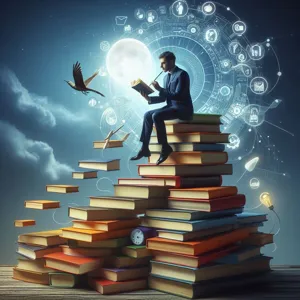
When it comes to seeking out books that transform life lessons into practical advice, the authors you choose can make all the difference. Here are some recommended authors whose works are rich with insights and transformative wisdom, each offering a unique perspective that can inspire and guide you on your personal journey.
**1. Brené Brown**
Brené Brown’s exploration of vulnerability, courage, and authenticity has resonated with countless readers. Her books, like *Daring Greatly* and *Rising Strong*, delve into the intricacies of emotional resilience and the power of embracing imperfection. Brown’s engaging writing style and relatable anecdotes make her insights not only accessible but also actionable, encouraging readers to step bravely into their own stories.
**2. Malcolm Gladwell**
Known for his thought-provoking analyses of social phenomena, Malcolm Gladwell’s books such as *Outliers* and *The Tipping Point* challenge conventional wisdom and provide a fresh lens through which to view success and human behavior. Gladwell’s ability to weave research with storytelling offers practical lessons that are both enlightening and applicable to everyday life.
**3. Elizabeth Gilbert**
In her bestselling memoir *Eat, Pray, Love*, Elizabeth Gilbert takes readers on a journey of self-discovery and healing. Her subsequent works, including *Big Magic*, explore creativity and the importance of pursuing one’s passions. Gilbert’s candid reflections and empowering advice encourage readers to embrace their true selves and live authentically.
**4. Deepak Chopra**
For those seeking a spiritual dimension to their life lessons, Deepak Chopra offers a treasure trove of wisdom. His books, such as *The Seven Spiritual Laws of Success*, blend Eastern philosophy with Western practicality, providing readers with insights on how to achieve balance and fulfillment. Chopra’s holistic approach to personal growth emphasizes the interconnectedness of mind, body, and spirit.
**5. Tony Robbins**
Renowned for his motivational speaking and life-coaching prowess, Tony Robbins’ works, including *Awaken the Giant Within*, are filled with actionable strategies for personal empowerment and success. Robbins’ dynamic writing style and practical exercises inspire readers to take charge of their lives and make meaningful changes.
By exploring the works of these transformative authors, you’ll discover not just advice, but actionable steps that can lead to profound changes in your life. Their unique perspectives and insights can help you unlock the wisdom needed to tackle challenges, pursue passions, and cultivate a life filled with purpose and fulfillment. Whether you’re looking for inspiration, motivation, or practical strategies, these authors offer a wealth of knowledge that can guide you on your journey.
6. The Role of Personal Experience in Learning from Books
The Role of Personal Experience in Learning from Books
When it comes to transforming life lessons into practical advice, the significance of personal experience cannot be overstated. Books are often reflections of the authors’ journeys, filled with insights, anecdotes, and wisdom garnered from their unique life paths. However, it’s essential to recognize that every reader brings their own experiences to the table, shaping how they interpret and apply the lessons found within the pages.
Personal experience acts as a lens through which we comprehend and absorb information. For instance, a reader who has faced adversity may resonate deeply with a memoir centered on overcoming challenges. The struggles and triumphs detailed in the narrative may serve as a mirror, allowing them to see their own life reflected back, instilling a sense of hope and actionable strategies for navigating their circumstances.
Moreover, when engaging with a book, readers often find themselves connecting dots between the author’s insights and their own lived realities. This interaction not only enhances understanding but also facilitates a more profound application of the advice given. A self-help book on emotional intelligence, for example, may provide techniques for better communication, but it’s the reader’s previous encounters—both positive and negative—that will dictate how they implement these strategies in their own relationships.
Additionally, personal experience enriches the learning process by encouraging readers to question, critique, and adapt the advice they encounter. Each chapter serves as a stepping stone, prompting self-reflection and thoughtful consideration of how those lessons align with their values, goals, and life situations. This dynamic engagement transforms reading from a passive activity into an active dialogue, where the reader is not just absorbing information but actively reshaping it to fit their narrative.
Ultimately, the intersection of personal experience and literary wisdom creates a fertile ground for growth and transformation. By recognizing the importance of their own life stories in conjunction with the lessons found in books, readers can unlock a deeper understanding, leading to practical applications that resonate on a personal level. In this way, every book has the potential to not only inform but also inspire meaningful change, making the journey of self-discovery through literature an invaluable pursuit.
7. Strategies for Effective Reading and Retention
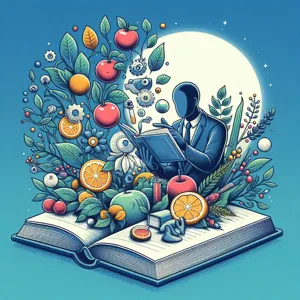
Effective reading and retention are crucial for transforming the knowledge gleaned from books into practical advice that can truly enrich your life. It’s not just about the quantity of books you consume, but the quality of your engagement with them. Here are some strategies to enhance your reading experience and ensure you absorb the invaluable lessons contained within the pages.
**1. Set Clear Intentions:** Before you dive into a new book, take a moment to clarify your intentions. What do you hope to gain from this reading? Are you looking for inspiration, practical tips, or a deeper understanding of a concept? Having a clear purpose will guide your reading and help you focus on the most relevant information.
**2. Take Notes:** Whether through margin scribbles, a dedicated notebook, or digital tools, jotting down key insights, quotes, or questions as you read can significantly enhance retention. Summarizing each chapter or section in your own words reinforces your understanding and serves as a handy reference for the future.
**3. Use the Feynman Technique:** Named after the brilliant physicist Richard Feynman, this technique involves explaining the concepts you’ve learned in simple terms, as if you were teaching someone else. This method not only solidifies your understanding but also highlights any gaps in your knowledge that you can revisit.
**4. Reflect and Apply:** After finishing a book, take time to reflect on its lessons and how they can be applied to your life. Create actionable steps based on what you’ve learned. This could mean setting specific goals, changing certain habits, or experimenting with new approaches inspired by the book’s content.
**5. Discuss with Others:** Engaging in discussions about what you’ve read can deepen your understanding and provide new perspectives. Join book clubs, online forums, or simply chat with friends who share your interests. This exchange of ideas can lead to memorable insights that resonate long after the reading is done.
**6. Revisit Key Sections:** Don’t hesitate to reread certain chapters or passages that struck a chord with you. Revisiting material can reinforce your understanding and allow you to glean new insights you may have missed during your first read.
By implementing these strategies into your reading routine, you can transform passive reading into an active, engaging process that not only enriches your mind but also empowers you to apply life lessons effectively in your daily experiences. Remember, the goal is not just to read but to absorb and implement the wisdom found within the pages.
8. Creating a Reading List of Life-Changing Books
Creating a reading list of life-changing books is an essential step in your journey toward personal growth and self-improvement. With countless titles available, the sheer volume can feel overwhelming. However, curating a thoughtful selection can make all the difference in transforming abstract life lessons into actionable insights.
Start by reflecting on the areas of your life that you wish to improve. Are you seeking guidance on relationships, career development, or emotional resilience? This introspection will help you pinpoint the themes that resonate most with your current situation. Next, tap into resources like book recommendation websites, avid reader blogs, or even social media platforms where book lovers share their favorites. Engaging with reading communities can provide insights into which titles have made a significant impact on others.
Consider incorporating a mix of genres to enrich your perspective. Combining memoirs, self-help guides, philosophical texts, and even fiction can ensure a well-rounded exposure to different viewpoints and experiences. For instance, a memoir can provide personal anecdotes that inspire, while a self-help book might offer structured advice and exercises to implement in your daily life.
Once you’ve compiled your initial list, set aside dedicated reading time each week to dive into these transformative texts. As you read, take notes on key takeaways and how they apply to your own life. This active engagement will enable you to internalize the wisdom contained within the pages, making it easier to translate those lessons into practical actions.
Lastly, don’t hesitate to revisit and revise your list as your journey unfolds. New interests may arise, and different books may resonate with you at various stages of your life. By continuously nurturing your reading list, you’ll ensure that you always have a source of inspiration and practical advice at your fingertips, ready to guide you through the complexities of life.
9. How to Apply Lessons Learned from Books in Daily Life
Reading transformational books is just the first step in a journey toward personal growth and practical application. The true magic happens when you actively integrate the lessons you’ve learned into your daily life. Here are some effective strategies to help you do just that.
First, start by taking notes while you read. Jot down key insights, quotes, and ideas that resonate with you. This not only reinforces your understanding but also creates a personal reference you can revisit. After finishing a book, select a few pivotal lessons and distill them into actionable steps. For instance, if a book emphasizes the importance of gratitude, you might decide to keep a gratitude journal where you jot down three things you’re thankful for each day.
Next, create a daily or weekly ritual that incorporates these lessons. This could be as simple as dedicating a few minutes each morning to reflect on a principle you learned, or setting reminders to practice mindfulness or time management techniques discussed in the book. Consistency is key; by establishing these rituals, the lessons become ingrained in your routine.
Moreover, consider sharing your insights with others. Engaging in discussions about the books you’ve read with friends, family, or even online communities can deepen your understanding and provide new perspectives. You might find that teaching someone else is one of the most effective ways to solidify your own knowledge.
Finally, allow yourself the flexibility to adapt these lessons as you see fit. Life is dynamic, and what works for one person may not resonate with another. Be open to experimenting with different approaches and adjusting them to suit your unique circumstances.
By actively applying the wisdom gleaned from your reading, you not only enrich your own life but also inspire those around you. Each book has the potential to be a catalyst for change—it’s up to you to unlock that potential and transform insights into action.
10. Engaging with Book Communities and Discussions
Engaging with book communities and discussions can significantly enhance your reading experience and help you discover transformative books that resonate with your life journey. In today’s digital age, a wealth of platforms exists where book lovers gather to share their insights, recommendations, and experiences. Whether it’s joining an online forum, participating in a local book club, or following book influencers on social media, immersing yourself in these communities can expose you to a diverse array of literature that may not be on your radar.
One of the most enriching aspects of engaging with fellow readers is the opportunity for discussion. These conversations often evolve into deep explorations of themes, characters, and lessons learned from the books. Platforms like Goodreads, Reddit, and various Facebook groups serve as vibrant hubs where readers can ask questions, share thoughts, and gain different perspectives on the same book. Participating in these discussions not only broadens your understanding but can also spark a desire to explore new genres and authors you might not have considered before.
Moreover, attending author talks, book signings, and literary festivals can further deepen your connection to the literary world. Listening to authors discuss their motivations and the real-life experiences that inspired their work can provide invaluable context and insights into how to apply their lessons in your own life. Engaging with book communities not only nurtures your passion for reading but also cultivates a supportive network of fellow seekers who share your quest for knowledge and personal growth. So, dive into these communities, share your thoughts, and let the collective wisdom of fellow readers guide you toward books that truly transform your understanding of life.
11. Journaling Insights from Your Reading Journey
Journaling insights from your reading journey is a powerful practice that can deepen your understanding and retention of the transformative lessons you encounter in the books you read. As you immerse yourself in the narratives, theories, and practical advice offered by authors, take the time to pause, reflect, and jot down your thoughts, feelings, and revelations.
Begin by dedicating a special notebook or digital document to your reading reflections. Each time you finish a chapter or a particularly impactful passage, write down key takeaways that resonate with you. What concepts challenged your thinking? Which ideas sparked a sense of motivation or clarity? By articulating these insights, you create a personal repository of wisdom that you can revisit whenever you need encouragement or guidance.
Incorporate questions into your journaling practice, prompting deeper exploration of the material. Ask yourself how the lessons from the book apply to your life, what changes you could implement, and how you can integrate these lessons into your daily routine. This active engagement fosters a more profound connection with the text and encourages you to take actionable steps towards personal growth.
Additionally, consider pairing your insights with specific goals or intentions. For instance, if a book inspires you to cultivate gratitude, jot down daily practices you can adopt and reflect on your progress in subsequent entries. Over time, your journal becomes not just a collection of thoughts, but a living document that maps your journey of change, allowing you to track your evolution and celebrate milestones along the way.
In essence, journaling serves as both a mirror and a guide, reflecting the insights gleaned from your reading while illuminating the path forward. It transforms passive reading into an active dialogue between you and the authors, paving the way for life lessons to manifest as practical, everyday wisdom. So grab your pen or keyboard, and let the journey of self-discovery through journaling enrich your reading experience.
12. Balancing Fiction and Non-Fiction for Broader Perspectives
When it comes to unlocking wisdom through literature, the age-old debate of fiction versus non-fiction often arises. However, the secret to truly transformative reading lies in striking a balance between the two. Each genre offers unique insights that can enhance your understanding of life, human behavior, and the world around you.
Fiction, with its rich tapestry of characters and narratives, allows readers to immerse themselves in diverse perspectives and experiences. Through the eyes of a resilient protagonist facing adversity or a complex antagonist grappling with their own demons, you gain a deeper empathy for situations and emotions that may be far removed from your own reality. Novels like “The Alchemist” by Paulo Coelho encourage introspection and the pursuit of dreams, while contemporary works like “Little Fires Everywhere” by Celeste Ng delve into the intricacies of family dynamics and societal expectations. These stories not only entertain but also challenge you to contemplate your own values and choices.
On the other hand, non-fiction serves as a wellspring of practical advice grounded in reality. From self-help titles like “Atomic Habits” by James Clear, which offers actionable strategies for personal development, to memoirs like “Becoming” by Michelle Obama, which provide real-life lessons of resilience and leadership, non-fiction equips you with tools and frameworks to navigate life’s complexities. These books often draw on research, expert insights, and lived experiences, allowing you to apply their teachings to your own journey.
By weaving both fiction and non-fiction into your reading habits, you cultivate a broader perspective that enriches your understanding of life. The imaginative narratives of fiction spark creativity and emotional intelligence, while the grounded principles of non-fiction offer guidance and clarity. This melding of genres not only deepens your comprehension of the human experience but also empowers you to transform those lessons into practical, actionable advice that can lead to profound personal growth. So, as you embark on your literary journey, remember to embrace the harmonious dance between fiction and non-fiction for a richer, more transformative reading experience.
13. The Impact of Audiobooks and Podcasts on Learning
In an age where multitasking and on-the-go lifestyles have become the norm, audiobooks and podcasts have emerged as powerful tools for transforming life lessons into practical advice. These audio formats offer a unique blend of convenience and accessibility, allowing you to absorb wisdom from the written word while commuting, exercising, or even doing household chores.
Audiobooks bring literature to life, enabling you to experience the nuances of a narrative through the intonation and emotion of a skilled narrator. This auditory experience can deepen your understanding of complex themes and characters, making the lessons more relatable and applicable to your own life. Imagine listening to a self-help book on personal development while jogging in the park — the rhythm of your feet matching the cadence of inspirational insights, creating a perfect synergy of mind and body.
Similarly, podcasts have revolutionized the way we consume knowledge, offering a diverse array of topics hosted by experts, thought leaders, and everyday individuals sharing their transformative journeys. With episodes ranging from interviews with bestselling authors to discussions on philosophical ideas, podcasts invite you to engage with ideas in real-time, often sparking your own reflections and insights. The conversational nature of podcasts creates an intimate connection, making it feel as though you’re part of a dialogue rather than a passive listener.
Moreover, both audiobooks and podcasts cater to different learning styles. For auditory learners, these formats can enhance retention and comprehension, allowing for a more immersive and engaging experience. They also serve as a great supplement to traditional reading, enabling you to revisit important concepts while reinforcing the lessons you’re learning.
Incorporating audiobooks and podcasts into your personal development journey not only broadens your horizons but also keeps you motivated and inspired. As you unlock the wisdom contained within these audio resources, you’ll find that life lessons become more actionable, equipping you with practical advice to navigate your own challenges. So, plug in, tune out the noise, and let the transformative power of sound guide you on your path to growth.
14. Revisiting Books: The Importance of Second Readings
Revisiting books is an often-overlooked practice that can unlock deeper insights and reinforce the life lessons they impart. When we read a book for the first time, we are typically focused on the narrative or the core concepts, absorbing the information at face value. However, our understanding evolves as we grow and experience life, making second readings an invaluable tool for personal development.
Consider this: the challenges you face today may frame your perspective on a book differently than they did a year ago. With each pass through the pages, you bring new experiences, emotions, and insights that can alter your interpretation of the text. This fresh lens allows you to engage with the material on a more profound level, often revealing nuances and subtleties that may have gone unnoticed during your initial reading.
For instance, a self-help book that once provided surface-level motivation may resonate on a deeper emotional or practical level upon a second reading, as you apply its lessons to your current circumstances. You might find that certain passages leap out at you, speaking directly to your present situation, or that you can now connect ideas in ways you couldn’t before. The wisdom contained in those pages often feels like it has expanded, offering new tools and strategies for navigating life’s complexities.
Moreover, revisiting a book can reinforce the lessons learned and solidify them in your memory. Just as we practice skills repeatedly to achieve mastery, revisiting literature enhances our understanding and retention of its teachings. It encourages us to reflect on our personal growth and how far we’ve come since our last encounter with the text.
Incorporating second readings into your literary routine can be transformative, turning a solitary act of reading into an ongoing dialogue with the author and the ideas presented. So, the next time you finish a book that resonates with you, consider picking it up again down the road. You might be surprised at how much more it has to offer, illuminating your path with renewed clarity and wisdom.
15. Conclusion: The Continuous Journey of Learning Through Books
In conclusion, the quest for knowledge through books is not merely a one-time endeavor; it is a continuous journey that unfolds over a lifetime. Each book we encounter opens a new door to understanding, offering insights that resonate with our personal experiences and challenges. The transformative power of literature lies in its ability to provide not just theoretical knowledge, but practical advice that we can apply to our everyday lives.
As we navigate this journey, we must remain open to the myriad of voices and perspectives that literature offers. Whether it’s a self-help guide that inspires us to take action, a memoir that reveals the authentic struggles of another, or a novel that challenges our worldview, each book can serve as a stepping stone toward personal growth. The key is to approach every reading experience with curiosity and a willingness to engage deeply with the material.
Remember, the journey of learning through books is also about reflection and application. Take the lessons you glean from your reading and integrate them into your life. Share insights with others, engage in discussions, and consider how each piece of wisdom can shape your actions and decisions.
Ultimately, books are not just vessels of knowledge; they are companions that accompany us on our path to self-discovery and enlightenment. Embrace the journey, for every book has the potential to transform not only your understanding but also your life. Happy reading!
As we conclude our exploration of how to unlock wisdom through transformative literature, we hope you feel inspired to embark on your own journey of discovery. The right book can illuminate paths you never knew existed, turning abstract life lessons into actionable insights that resonate with your unique experiences. By applying the strategies outlined in this post—such as seeking recommendations, exploring diverse genres, and reflecting on your personal growth—you’ll be well-equipped to curate a reading list that speaks to your heart and mind. Remember, every great transformation begins with a single page turned. So, grab that book that’s been calling your name and allow its wisdom to guide you toward a more fulfilling life. Happy reading!





